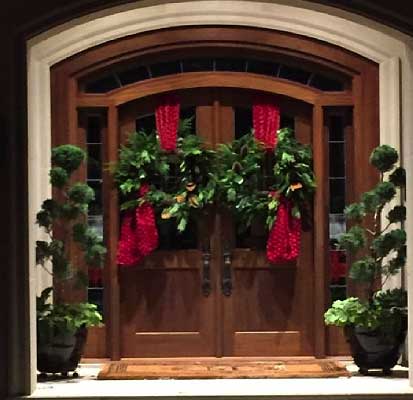A Welcoming Holiday Entryway

Who among us does not like a front door and entryway that’s been decorated for the season? We know how important first impressions can be. The entrance to your house is a visitor’s first impression. Seeing nicely decorated front doors reminds us that the design of your front door, front porch or portico, and the entire arrival and entry experience must be well thought out when designing your house. It sets the tone of the design. You won’t get a second chance to make a first impression. Be sure you present the image and feel that is consistent with the overall house.
I try to create a “graduated” degree of inside versus outside and a thoughtful transition from the public domain of the street to the private domain of your home with the entryways I design, regardless of house style. This is one of the key tenets in making a house “feel” right.
Unfortunately, many houses are designed and built where this transition occurs abruptly in one or two steps. I’m referring to houses where you simply walk up to the front door and step through right into the living room. I guarantee this feels uncomfortable to you even if you can’t explain why except to say that it seems to compromise the privacy of the living room. Actually, what is happening is there was no “middle place” to let your mind adjust from public to private. There is no place where the visitor, or you, can be inside the house, yet not be completely inside the house.
Front steps, porches, vestibules, and defined foyers are all part of a better entry transition from outside to in and public to private.
You really need at least two intermediate places to make an entryway feel right. First would be a front step and porch. These are still open to the public, but they have some private aspect to them since they “belong” to the house and the porch might even be covered, thus making it become a little bit of an indoor space. I consider this space to be 75% public and 25% private.
Next is your foyer.
It’s much more private because it is inside your house and beyond your front door, but it is not as private as your family room. It still carries some publicness because you greet guests there, visitors can see into it from the front door, and there is no sitting furniture indicating that people linger there. I consider this space to be 25% public and 75% private.
Including these two semi-public and semi-private spaces as part of the entry experience, no matter how small they may be, will make your house feel more comfortable and the design will feel more “resolved.” Most people cannot verbalize why some entryways feel right and others feel wrong. I would suggest that the omission of proper transition spaces is usually the cause of things feeling wrong.
This idea about the entrance to a house and the concept of transitioning from public to private might not have been on you design radar screen. But it should be. It’s a concept I discuss in some detail in Designing Your Perfect House.
Our minds seek order. Our senses are uncomfortable with abrupt changes. We like gradual transitions. If you consider the sensation when you step from your dark bedroom in the middle of the night and turn on the light in the bathroom, you get a pretty good idea of how harsh a change can feel. Our psyche reacts to changes in spaces, albeit subconsciously, the same way. Sudden shifts from one type of space to another can be jarring and disconcerting. Transitions that feel nature and unforced are the key to designing your perfect house.

Happy Holidays!
Be sure to leave a comment. Tell us your story!
I hope this information is helpful to you. You might want to get yourself a copy of my best-seller, Designing Your Perfect House. It is chockfull of valuable tips and advice that will save you many times the cost of the book on your house building or remodeling project. You might also like The Well-Centered Home: Simple Steps to Increase Mindfulness, Self-Awareness, and Happiness Where You Live. It will show you how to make your home a happy place.

